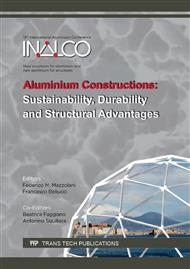p.275
p.281
p.288
p.295
p.303
p.309
p.315
p.321
p.327
Torsional-Flexural Critical Force for Various Boundary Conditions
Abstract:
The system of governing differential equations of stability of members with the rigid open cross-sections was developed by Vlasov [1] in 1940. Goľdenvejzer [2] published in 1941 solution of this system by an approximate method. He proposed formula for torsional-flexural critical force Ncr.TF calculation which is modified and used in EN 1999-1-1 [3] (I.19). By introducing factor αzw he take into account any combination of boundary conditions (BCs).The purpose of this paper is to verify this formula and explore the possibility to improve the factor αzw. In the large parametrical study the authors investigated a lot of different shape of cross-sections, all 100 theoretical possible combinations of BCs and various member lengths. All results are evaluated regarding the reference results by finite element method (FEM).
Info:
Periodical:
Pages:
303-308
Citation:
Online since:
September 2016
Authors:
Price:
Сopyright:
© 2016 Trans Tech Publications Ltd. All Rights Reserved
Share:
Citation:


